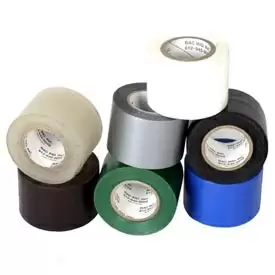
You have invested in tarps to protect your equipment and possessions. They are doing their job and keeping the items safe, protected, and functional. Over time these tarps might show some issues in the form of holes, tears, or thinning in areas as a result of the shielding it performs from the harshness of wind, rain, sun, and other threats. With a few supplies and some understanding repairing tarps can be quite easy extending the life of these coverings saving you money.
Throughout the tarp industry there are a variety of diverse covering materials used for different tasks and purposes. Canvas tarps, vinyl tarps, poly tarps, and mesh tarps are all made with different material and some with reinforcing and special protective coatings and substances. To follow are the common ways of repairing tarps depending on the extent of the damage and type of fabric that includes repair tape, cement, patches, and grommet mending.
Tarp Repair Tape
Depending on the form of damage or stress that is showing from usage, tarp repair tape is a quick and extremely effective application. With this tool, rips will be mended and stress points reinforced preventing further or potential tearing. This tape can have uses beyond tears. Because of the strong adhesive glue it possesses, the tape can strongly join two or more tarps together.
Tarp Repair Tape appears with heavy mesh threading and is usually free from tearing, helping secure the covering for a long period of time. Repair tape is available in rolls of canvas repair tape, vinyl repair tape, and poly repair tape. These rolls are available in a variety of colors to match your tarp or situation.
The tarp repair tarp is a versatile application, especially the vinyl tape that is thick and strong. It has benefits beyond tarp repair for uses including home, construction, agriculture, and boating.
Tarp Glue
A number of products are available in the form of adhesive glue to help quickly and solidly repair tarps. Vinyl, rubber, canvas, leather, and other materials can utilize the bonding benefits. The tarp glue is easy to be smoothly brushed on. It is fast drying, setting hold usually in two to five minutes. The glue is resistant to water, chemicals, grease, fuel, and oils along with temperature and weather extremes.
Tarp Patching
Patching kits are available with the matching tarp material to mend larger tears and holes secured with the glue. Extra tarp material is possible to be cut into patches as long as the fabric is in good shape and you have the proper glue/cement to match.
Canvas is the only tarp material that is good for sewing. A sturdy thread matching the material of the canvas is a must and performed with a heavy-duty machine or by hand with a special sailmaker’s needle. The sewn area has to become waterproof with commercial waterproof compounds or beeswax.
Grommet Mending
Grommets or tarp eyelets are an important part of your tarp. They allow you to tie the covering down and keep the protected item consistently shielded. The duty and stress that they absorb will occasionally cause one or more grommets to become weak or have damage. Fixing the ones in question is necessary. Replacement grommets and grommet tool kits are available to quickly and easily be installed.
A few items and tools are helpful and a good idea to have around to receive the benefits of tarps. Besides the replacement grommets and washers, a hole cutter and a setting die will be necessary. These are provided in grommet kits that are readily available.
Most anything that you use will wear down in certain areas, especially where there is extreme or constant stress or weathering. This is the case with tarps that you use for protection of your important items. Knowing how and having the right supplies and tools available will help extend the life and usefulness of these coverings saving you money and time in the long run.
Contact Tarps now at (888) 800-1383 or sales@TarpsNow.com to speak with an experienced representative. We will help with the knowledge, products and tools necessary in repairing tarps.
